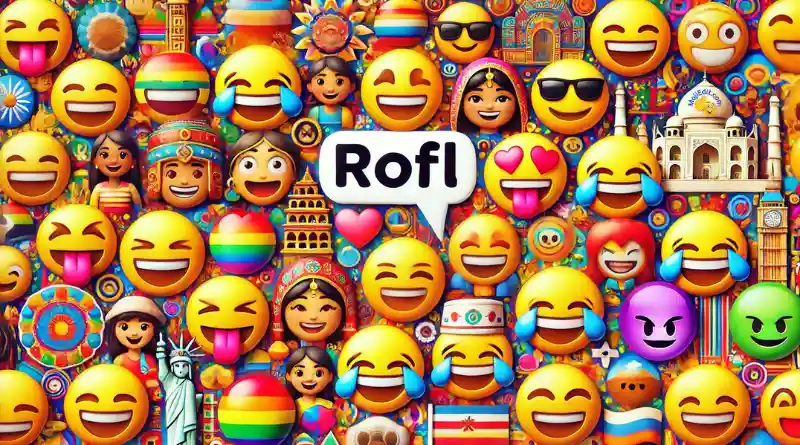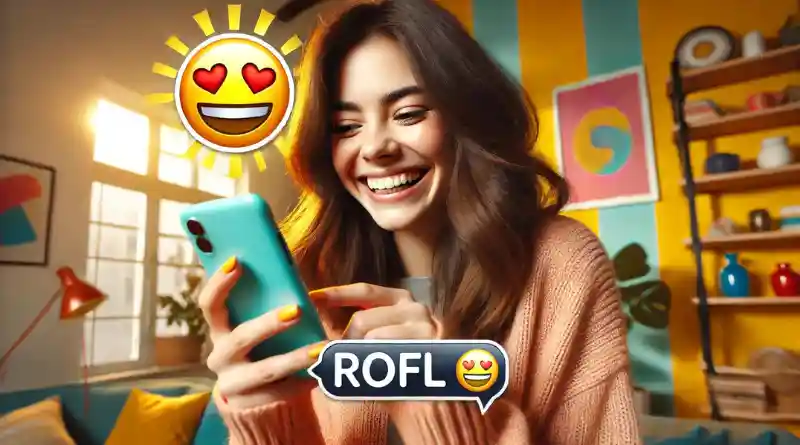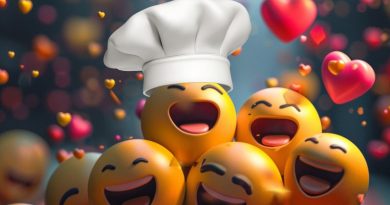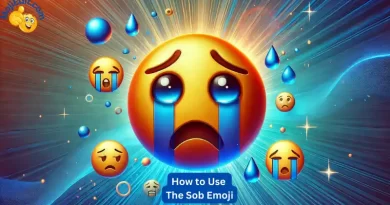ROFL Emoji : Le symbole qui se roule par terre en riant 🤣
Emojis have completely changed how we communicate, adding emotional depth and nuance to our digital conversations. Among the vast array of emojis, the ROFL emoji 🤣, short for “Rolling on the Floor Laughing,” stands out for its ability to make you laugh and convey uncontrollable laughter and intense joy! 😆
We will explore the relevance, usage, and cultural impact of the ROFL emoji, and how it enhances our online interactions.
Principaux enseignements
The ROFL emoji 🤣, with its expressive design and widespread appeal, plays a crucial role in enhancing digital communication. Here are the key takeaways from our exploration of this popular emoji:
Emotional Depth and Nuance
- The ROFL emoji adds significant emotional depth to digital conversations, effectively conveying almost unstoppable laughter and extreme amusement. Its exaggerated features help bridge the gap where words alone may fall short.
Utilisation et popularité
- Despite its expressive power, the ROFL emoji is less frequently used than some other popular emojis, like 😂 (Face with Tears of Joy). Its use varies significantly across different age groups and cultural contexts.
Différences culturelles
- Understanding cultural differences in emoji usage is crucial for effective communication. While the ROFL emoji is widely recognized in many Western countries, its use and interpretation can vary in Eastern cultures and more formal contexts.
Combinaisons d'Emoji
- Combining the ROFL emoji with other emojis, such as 😂 (Face with Tears of Joy), 🤪 (Zany Face), and 🙄 (Rolling Eyes), can create nuanced expressions and enhance the humor in your messages.
Communication numérique
- The ROFL emoji, along with other emojis, plays a significant role in reducing misunderstandings, building emotional connections, and making digital communication more engaging and relatable.
Copy and Paste the ROFL Emoji 🤣
Want to add some uncontrollable laughter to your messages or posts? You can easily copy the ROFL emoji and paste it wherever you need a touch of humor. Just follow these simple steps:
- Click the “Copy” button below to copy the ROFL emoji to your clipboard.
Emoji Copied! 🤣
- Allez à l'endroit où vous souhaitez utiliser l'emoji et cliquez avec le bouton droit de la souris sur le champ de texte.
- Choisissez "Coller" dans le menu contextuel ou utilisez simplement le raccourci clavier Ctrl + V (Windows) ou Cmd + V (Mac) pour coller l'emoji.
And voilà! You’re all set to add some laughter to your conversations.
The History of the ROFL Emoji 🤣
The ROFL emoji, short for “Rolling on the Floor Laughing,” has a fascinating history that reflects its widespread popularity and impact on digital communication. Here’s a detailed look at its origins, development, and technical details.
Unicode Approval and Release
The ROFL emoji was officially approved as part of Unicode 9.0 in June 2016. Unicode is a global standard for text representation in computers and other devices, ensuring that emojis and other characters are consistently displayed across different platforms and devices.
Emoji Version and Release
Along with its inclusion in Unicode 9.0, the ROFL emoji was also added to Emoji 3.0, which was released concurrently. This version update included many new emojis, expanding the visual vocabulary available for digital communication.
Détails techniques
- Point de code Unicode: The unique identifier for the ROFL emoji in the Unicode Standard is U+1F923. This hexadecimal code ensures that the emoji is recognized and displayed correctly across various systems.
- HTML Entity: In HTML, the ROFL emoji can be represented by
🤣ou🤣. - Other Formats: For programming and text encoding purposes, the ROFL emoji can be represented in several formats:
- C, C++, Python:
\U0001F923 - Java, JavaScript, JSON:
\uD83E\uDD23 - Perl:
\x{1F923} - PHP, Ruby:
\u{1F923} - Code d'échappement de l'URL:
%F0%9F%A4%A3
- C, C++, Python:
Design and Variations
The design of the ROFL emoji varies slightly across different platforms, but it generally features a yellow face with a wide-open mouth, closed eyes, and tears of joy streaming down its face. The face is tilted to the side, suggesting a state of uncontrollable laughter. Some platforms may add unique elements, such as different angles or styles of tears:
- Pomme: A yellow face tilted right with closed eyes and an open mouth, tears flowing from the eyes.
- Google: Similar to Apple but sometimes with a more pronounced tilt and larger tears.
- WhatsApp: Features a face that tilts to the right with similar expressions.
- Samsung: A unique style that often incorporates distinct design elements like thicker tears.
Cultural Impact and Usage
Since its release, the ROFL emoji has become one of the most popular emojis for expressing extreme amusement and joy. It is frequently used on social media platforms like Twitter, Instagram, and Facebook to react to funny content. The emoji’s popularity reflects its ability to convey a strong emotional response in a simple, visual form.
Faits amusants
The ROFL emoji was introduced to provide a more expressive alternative to the 😂 (Face with Tears of Joy) emoji, which was previously the go-to symbol for laughter. The exaggerated features of the ROFL emoji make it ideal for situations where something is not just funny but hilariously so.
The ROFL emoji’s journey from proposal to widespread usage highlights the importance of visual language in digital communication. Its technical specifications ensure it is consistently represented across different platforms, making it a reliable tool for expressing intense laughter and joy.
The Anatomy of the ROFL Emoji 🤣
Visual Features
The ROFL emoji, known as the “Rolling on the Floor Laughing” emoji, shows a yellow face with a wide-open mouth, closed eyes, and tears of joy streaming down its face. This expressive icon captures the essence of uncontrollable laughter. Therefore, it serves as an iconic symbol for intense amusement.
Variations de conception d'une plate-forme à l'autre
Different platforms display the ROFL emoji with slight variations. For example:
- Pomme : A yellow face tilted right with closed eyes and an open mouth, tears flowing from the eyes.
- Google : Similar to Apple but sometimes with a more pronounced tilt and larger tears.
- WhatsApp : Features a face that tilts to the right with similar expressions.
- Samsung : A unique style that often incorporates distinct design elements like thicker tears.
These variations influence how people perceive the emoji in digital communication. Consequently, this adaptability enhances its use across different devices and platforms.
Contexte historique
The ROFL emoji became part of Unicode 9.0 in 2016 and joined Emoji 3.0 in the same year. Unicode created it to offer a more exaggerated and visually expressive alternative to the 😂 “Face with Tears of Joy” emoji.
Symbolism and Emotional Impact
This emoji symbolizes unstoppable laughter. People often use it to indicate something extremely funny, as if they are figuratively “rolling on the floor laughing.” Its exaggerated features make it a powerful tool for conveying amusement in digital format. Therefore, it enhances the emotional depth of online conversations.
Importance culturelle
Interestingly, the use of the ROFL emoji varies by culture. In Western countries like the United States and the United Kingdom, people use it widely to express amusement in casual conversations. On the other hand, in Eastern cultures, people might prefer different emojis to express similar emotions due to varying cultural norms and digital communication styles.
Usage and Popularity 🤣
The Power of Laughter
Laughter is a universal language, and the ROFL emoji embodies that perfectly. Whether reacting to a hilarious meme, a funny story, or a clever joke, people use this emoji to express uncontrollable laughter. Its exaggerated features and dynamic pose make it clear that the situation is genuinely funny. As a result, it allows for a strong emotional connection in digital conversations.
Fréquence d'utilisation
Despite its expressive power, people surprisingly underuse the ROFL emoji compared to other popular emojis. In 2023, the “Rolling on the Floor Laughing” emoji ranked as the third most mentioned emoji on social media platforms. It was followed by the “Face with Tears of Joy” 😂 and the “Cœur rouge” ❤️ emojis. This data shows that while the ROFL emoji is popular, it is not as frequently used as some other emojis that convey more common emotions like love and happiness.
Tendances culturelles et démographiques
Emoji usage varies across different age groups. Generation Z, for instance, is known for its dynamic and expressive communication style, often using a wide variety of emojis, including the ROFL emoji. This younger generation embraces digital expression more than older generations.
Médias sociaux et messagerie
Emojis play a crucial role in social media and messaging platforms. In 2023, nearly one in five tweets included an emoji, and people sent billions of emojis daily on platforms like Facebook Messenger. The ROFL emoji is often used in these contexts to react to funny posts, comments, and messages, adding humor and engagement to online interactions.
The Emotional Impact of the ROFL Emoji 🤣
Expressing Joy and Amusement
The ROFL emoji powerfully expresses joy and amusement. It conveys unstoppable laughter, clearly showing that the user finds something exceptionally funny. This shared humor and joy help create a sense of connection, enhancing social bonds and fostering a positive online environment. Studies have shown that emojis, including the ROFL emoji, act as proxies for non-verbal cues in digital communication. They effectively convey emotions like laughter and joy, which would otherwise be expressed through facial expressions and body language in face-to-face interactions.
Enhancing Digital Communication
In online communication, tone and emotions can often be lost. The ROFL emoji bridges this gap by conveying intense emotions with a single icon. This ensures that the intended humor or amusement is accurately communicated, reducing misunderstandings and enriching the conversation. Emojis add an emotional layer to text, making it more engaging and relatable. For example, a message with the ROFL emoji can immediately show that the sender is laughing out loud, making the interaction more lively and genuine.
Building Emotional Connections
The ROFL emoji also helps build emotional connections between people. By sharing moments of laughter, individuals can strengthen their relationships and create a sense of camaraderie. This is particularly important in digital spaces where physical presence is absent, and maintaining emotional connections can be challenging. Emojis like the ROFL emoji bridge this gap, making digital interactions feel more personal and connected.
Versatility in Communication
The ROFL emoji’s versatility allows it to be used in various contexts. People use it to react to funny memes and jokes or to lighten the mood in serious conversations. Its expressive nature makes it a favorite among users who want to add a touch of humor to their messages. Additionally, combining the ROFL emoji with other funny emojis can create even more nuanced expressions. This amplifies the sense of almost uncontrollable laughter and makes the conversation more engaging and fun.
How I Use the ROFL Emoji in My Texts 🤣
Emojis are my jam, especially the ROFL emoji 🤣. Let me share how I use this versatile little icon in my daily texts and online interactions.
Sharing a Laugh with Friends
When I’m chatting with my friends, humor is a big part of our conversations. If someone sends a hilarious meme or a funny story, my go-to response is the ROFL emoji. It’s perfect for showing that something genuinely cracked me up. For example, if my friend sends a funny TikTok video, I might reply with:
“OMG, this is too funny 🤣!”
It immediately conveys that I’m laughing out loud, almost rolling on the floor.
Lightening the Mood
Sometimes, conversations can get a bit serious, and I love using the ROFL emoji to lighten the mood. For instance, if we’re discussing a stressful day at work or school, I’ll throw in a funny anecdote followed by the ROFL emoji to bring some cheer. Here’s an example:
“Had the worst day at work, but then I tripped over my own shoelaces in front of everyone 🤣. Guess it wasn’t all bad!”
This way, it not only shares a laugh but also shows that I’m not taking things too seriously.
Adding Sarcasm
Sarcasm is another area where the ROFL emoji shines. If someone makes a ridiculously obvious statement, a sarcastic reply with a ROFL emoji can make the point without sounding harsh. For instance, if a friend says, “Wow, it’s really hot today,” on a scorching summer day, I might respond with:
“Really? I hadn’t noticed 🤣.”
It adds a playful touch to the sarcasm, making the conversation more light-hearted.
Combining with Other Emojis
I love getting creative with emoji combinations to express different levels of laughter. Sometimes, I’ll pair the ROFL emoji with the 😂 (Face with Tears of Joy) or the 🤪 (Zany Face) emojis to show escalating laughter. For example:
“That joke was hilarious 😂🤣🤪!”
This combination shows that I found the joke extremely funny and a bit wild.
Engaging with Followers
As a blogger, engaging with my followers is super important. I often use the ROFL emoji in replies to their comments on my posts. It’s a great way to connect with them and show that I appreciate their humor. For instance, if someone leaves a funny comment on one of my posts, I might reply with:
“You crack me up 🤣!”
It makes the interaction more personal and fun.
Telling Stories
Using the ROFL emoji in storytelling is another fun way to engage my audience. I might share a sequence of emojis to narrate a funny incident. For example:
“So, I walked into a glass door today 😹🤦♀️, and everyone saw it 🤣!”
This visual storytelling makes the content more relatable and entertaining.
Emojis like the ROFL emoji make digital conversations more lively and expressive. Whether I’m sharing a laugh, lightening the mood, adding sarcasm, or engaging with my followers, the ROFL emoji is my trusty sidekick in making sure my messages are as fun and expressive as possible. Try it out in your texts and see how it brings your conversations to life!
 My Favorite Emoji Combos 😍🎉
My Favorite Emoji Combos 😍🎉
Emojis are such a big part of how I express myself online, and I love getting creative with combinations to add more flavor to my texts. Here are some of my go-to emoji combos and how I use them to spice up my digital conversations.
The Ultimate Laughter Combo: 🤣😂🤪
When something is just too funny for words, I combine the ROFL emoji with the Face with Tears of Joy and the Zany Face emoji. This trio perfectly captures escalating laughter and silliness. Here’s how I might use it:
“That video had me in tears 🤣😂🤪!”
This combo shows that I found the content funny and a bit wild.
The Happy Vibes Combo: 😄🌞✨
To spread énergie positive and good vibes, I love using the Smiling Face with Open Mouth, the Sun, and the Sparkles emojis together. This combo is great for cheerful messages:
“Good morning! Hope you have an amazing day 😄🌞✨!”
It’s a perfect way to start the day on a positive note.
The Loving Laughter Combo: 😂❤️🤣
When I want to express both love and laughter, I mix the Face with Tears of Joy with the Red Heart and the ROFL emoji. It’s ideal for moments when something is both heartwarming and hilarious:
“I can’t stop laughing at your message 😂❤️🤣!”
This combo shows that the humor is not only appreciated but also loved.
The Excited Combo: 🎉😃🙌
For moments of excitement and célébration, I go with the Party Popper, Smiling Face with Open Mouth, and the Raising Hands emojis. This combo is great for sharing exciting news or celebrating achievements:
“Guess what? I got the job! 🎉😃🙌”
It captures the joy and excitement perfectly.
The Sarcastic Combo: 🙄😏🤣
When I’m being sarcastic or playful, I use the Face with Rolling Eyes, the Smirking Face, and the ROFL emoji. It’s perfect for light-hearted sarcasm:
“Oh sure, because I totally have nothing else to do 🙄😏🤣.”
This combo adds a playful edge to the sarcasm, making it clear that it’s all in good fun.
The Storytelling Combo: 📚🤣🌟
For storytelling, I like to mix the Book, ROFL emoji, and Star emojis. This combo is great for sharing funny anecdotes or experiences:
“Just finished the funniest book 📚🤣! Highly recommend it to everyone 🌟.”
It makes the story more engaging and visually appealing.
The Cute and Funny Combo: 😸🤣💕
When something is both cute and funny, I combine the Grinning Cat Face with Smiling Eyes, the ROFL emoji, and the Two Hearts emoji. It’s perfect for adorable and funny moments:
“My cat just did the funniest thing 😸🤣💕.”
This combo highlights both the cuteness and humor of the situation.
These are just a few of my favorite emoji combos. They help make my texts more expressive and fun, adding that extra bit of personality to my digital conversations. Try out some of these combos and see how they can brighten up your messages!
8 Related Emojis to the ROFL Emoji 🤣
The ROFL emoji 🤣 is a favorite for expressing almost uncontrollable laughter, but there are several other emojis that complement its use, enhancing digital conversations with various nuances of humor and joy. Here are some related emojis that work well alongside the ROFL emoji:
1. Face with Tears of Joy (😂)
The 😂 emoji is perhaps the most commonly used to express laughter. It shows a face laughing so hard that tears are coming out of its eyes, making it a perfect companion to the ROFL emoji for indicating something extremely funny (.
2. Zany Face (🤪)
The 🤪 emoji, with its tilted head, one eye larger than the other, and tongue sticking out, conveys a sense of wild, silly humor. It’s great for moments when the humor is a bit over the top and adds a playful touch to your messages.
3. Grinning Squinting Face (😆)
The 😆 emoji shows a face with eyes squeezed shut in laughter and a wide, open-mouthed grin. It’s perfect for expressing hearty laughter, complementing the ROFL emoji in showing genuine amusement.
4. Cat with Tears of Joy (😹)
For those who love adding a cute twist to their messages, the 😹 emoji chat is ideal. It combines the elements of laughter and cuteness, making it perfect for funny and adorable moments.
5. Rolling Eyes (🙄)
The 🙄 emoji is excellent for sarcastic humor. When paired with the ROFL emoji, it can convey that the laughter is about something absurd or ridiculous, adding a layer of sarcasm to your message.
6. Loudly Crying Face (😭)
Although typically used to show sadness, the 😭 emoji can also be used in a humorous context to show that something is so funny it’s causing someone to “cry” with laughter. It’s a great way to exaggerate the intensity of the humor.
7. Smiling Face with Open Mouth (😄)
The 😄 emoji shows a wide, open-mouthed smile with eyes closed, conveying joy and excitement. It’s a good fit for lighter moments of laughter and happiness.
8. Upside-Down Face (🙃)
The 🙃 emoji, a face turned upside down, suggests a sense of silliness or joking around. It’s useful for playful or mildly sarcastic contexts, adding a twist to your humorous messages (Projet Emoji).
These related emojis can enhance your digital conversations by providing a range of expressions for different types of humor and joy. Try mixing and matching these with the ROFL emoji to add depth and fun to your messages!
Cultural Differences in Emoji Usage 🌏🌍
The way emojis are used and interpreted can vary significantly across different cultures. The ROFL emoji 🤣, representing “Rolling on the Floor Laughing,” is no exception. While it universally conveys intense amusement, the contexts and frequency of its use can differ widely.
Western Countries
In Western countries like the United States, Canada, and the United Kingdom, the ROFL emoji is frequently used in casual digital conversations to express extreme laughter. It often appears in response to jokes, memes, and humorous anecdotes on social media platforms like Twitter, Instagram, and Facebook (Emojipedia) (EmoWiki). In these contexts, the emoji is a staple in conveying a high level of amusement and is a go-to for emphasizing the hilarity of a situation.
Eastern Countries
In some Eastern countries, the use of the ROFL emoji may be less prevalent compared to other laughter-related emojis. For example, in Japan and South Korea, users might prefer the 😂 (Face with Tears of Joy) emoji or other culturally specific symbols that convey laughter. These preferences are often influenced by local digital communication norms and cultural nuances in expressing emotions
Cultural Nuances and Context
Cultural differences also affect the interpretation of the ROFL emoji. In more formal or conservative cultures, excessive use of expressive emojis like the ROFL might be considered unprofessional or overly casual in certain contexts, such as workplace communication or formal online interactions.
Emojis in Cross-Cultural Communication
When communicating across cultures, it’s important to be mindful of these differences. Using emojis that are widely understood and accepted can help bridge the gap between diverse audiences. For instance, while the ROFL emoji is widely recognized, pairing it with universally accepted emojis like the 👍 (Thumbs Up) or the 😄 (Smiling Face with Open Mouth) can help ensure that the intended message is clear and well-received.
Examples of Cultural Preferences
- United States and Canada: Frequent use of the ROFL emoji in social media and texting to express extreme amusement.
- Japon: Preference for the 😂 emoji and other local symbols that represent laughter.
- Allemagne: Balanced use of the ROFL emoji, often in informal settings or among friends.
Tips for Using the ROFL Emoji in Cross-Cultural Communication
- Connaître son public: Understand the cultural context and preferences of your audience to use emojis appropriately.
- Combine with Universal Emojis: Pair the ROFL emoji with more universally understood emojis to enhance clarity.
- Moderation: Use the ROFL emoji in moderation in formal or mixed-cultural settings to avoid misinterpretation.
Understanding these cultural nuances can help you use the ROFL emoji more effectively, making your digital communication more inclusive and impactful.
Conclusion
The ROFL emoji 🤣 is more than just a symbol of laughter; it’s a powerful tool for enhancing digital communication. From expressing intense amusement to bridging cultural differences, the ROFL emoji adds emotional depth and nuance to our interactions. Whether you’re using it in a playful combo, understanding its technical aspects, or exploring its cultural variations, this emoji helps create a more connected and expressive online world. Embrace the versatility of the ROFL emoji to make your digital conversations more engaging, joyful, and relatable. Happy texting! 😄🎉
Questions fréquemment posées et réponses
The ROFL emoji 🤣 stands for “Rolling on the Floor Laughing.” It is used to express extreme laughter and amusement, often in response to something very funny.
The ROFL emoji was introduced in 2016 as part of Unicode 9.0 and Emoji 3.0, expanding the range of emojis available for expressing laughter and joy.
Yes, the ROFL emoji can be used to convey sarcasm, especially when reacting to an absurd or ironically funny statement. For example, “Oh sure, that makes perfect sense 🤣.
Common combinations include pairing the ROFL emoji with 😂 (Face with Tears of Joy) and 🤪 (Zany Face) to amplify the sense of uncontrollable laughter. For example, “That video was too funny 🤣😂🤪!
You can use the ROFL emoji to react to something hilariously funny. For example, “That joke had me rolling 🤣!

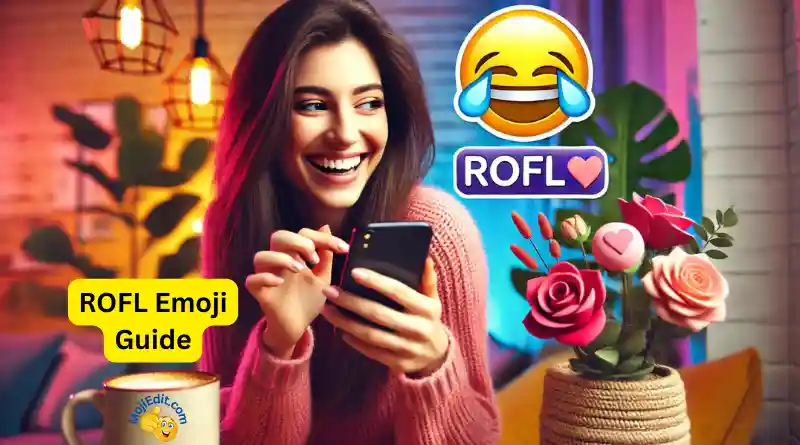
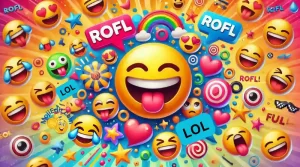 The Versatility of Emoji Combinations 🤣
The Versatility of Emoji Combinations 🤣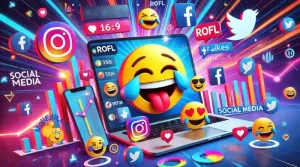 My Favorite Emoji Combos 😍🎉
My Favorite Emoji Combos 😍🎉